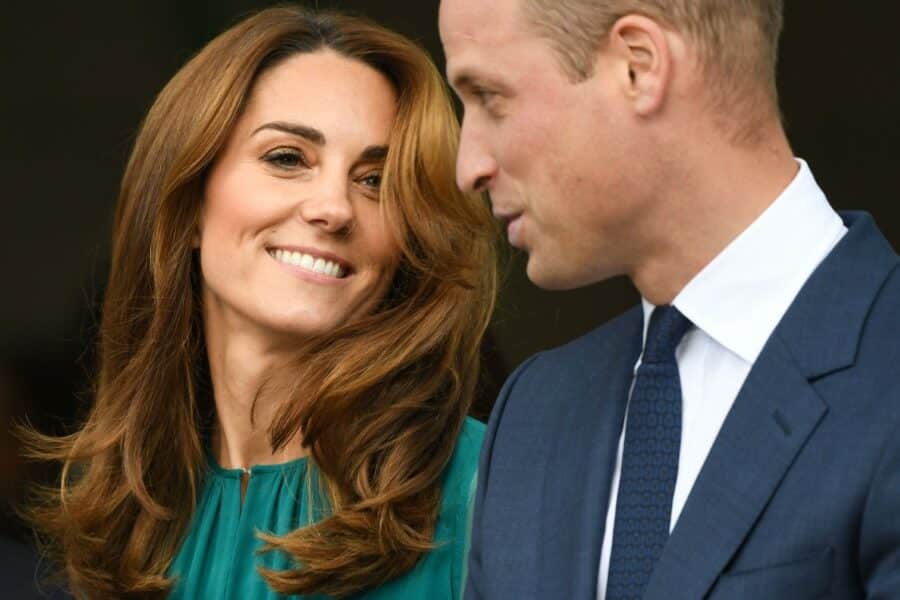William and Kate Middleton step up royal duties as King Charles III faces health problems
As King Charles III faces serious health challenges, Prince William and Kate Middleton have increasingly taken on prominent roles within the British monarchy. The monarch’s cancer diagnosis has expedited the transfer of responsibilities, placing William and Kate at the center of attention as the future of the Crown. Amid this period of uncertainty and transition, the couple has shown a strong commitment to maintaining the institution’s stability and reinforcing the royal family’s connection with the British public.
Since the announcement of King Charles III’s illness, William and Kate have expanded their public agendas, attending diplomatic events, visiting charitable organizations, and meeting with community leaders. These public appearances not only serve to strengthen the monarchy’s image but also prepare the British public for William’s eventual ascension to the throne. Kate Middleton, known for her dedication to social causes, has excelled at balancing royal traditions with a modern and accessible approach.
Despite limitations imposed by his treatment, King Charles III continues to perform some official duties. However, royal experts suggest that the gradual transfer of responsibilities to William and Kate is part of a strategic succession plan. The monarchy is working to ensure stability and continuity during this delicate period, minimizing the impact of the king’s absence from important events.
The evolving roles of William and Kate within the monarchy
William and Kate have played a crucial role in modernizing the British monarchy, using digital platforms to connect with the public and address contemporary social issues. William has focused on mental health initiatives and environmental causes, while Kate leads projects centered around early childhood development and education.
Their increased public presence reflects their commitment to keeping the Crown connected to the British citizens. Recent events have highlighted their diplomatic skills as they engage with both local and global issues, reinforcing their roles as future leaders. Additionally, William and Kate have emphasized values such as sustainability, equality, and inclusion in their royal duties.
The monarchy’s strategy is clear: prepare William and Kate not just to inherit the throne but to lead a modern institution that aligns with the values of the 21st century. Their active involvement in relevant social causes is seen as an effort to ensure the monarchy remains current and resonates with the public.
The impact of king Charles III’s health on the monarchy
King Charles III’s cancer diagnosis has sparked public concern and ignited discussions about the future of the monarchy. At 75 years old, the king is undergoing aggressive treatment, which has significantly limited his public appearances. While he continues to handle some administrative tasks, most of his public commitments have been suspended, leading to widespread anxiety among the British population.
The royal family has been transparent in managing the situation, providing regular updates about the king’s condition to maintain public trust and prevent speculation. The gradual shift of duties to William and Kate has been well received, with the public viewing the couple as a symbol of stability and continuity during this challenging time.
Recent surveys show that over 70% of Britons trust William and Kate to lead the monarchy in the future. The couple’s popularity has risen in recent years, particularly among younger generations who appreciate their accessible and modern approach to royal duties.
Key events that marked William and Kate’s preparation for the throne
Several recent events have highlighted William and Kate’s growing influence within the royal family. During a visit to northern England, the couple attended inaugurations and community meetings, demonstrating their dedication to the country’s roots. These appearances strengthened the monarchy’s relationship with the public while showcasing the couple’s readiness to assume the Crown.
William’s mental health initiatives and Kate’s work on early childhood development have further emphasized their vision of a more socially engaged monarchy. These efforts not only bolster their public image but also align the royal family with causes that deeply resonate with British society.
Their involvement in these initiatives underscores a proactive approach to leadership, demonstrating their commitment to using their platform to drive meaningful change.
Modernizing the british monarchy
The power transition from King Charles III to Prince William represents more than just a leadership change—it signals a broader shift in the monarchy’s approach to its role in modern society. William and Kate have adopted a more accessible and contemporary image, breaking away from traditional protocols while maintaining respect for royal heritage.
One of the most significant changes has been the strategic use of social media by the couple. Platforms like Instagram and Twitter allow William and Kate to share personal and professional moments with millions of followers, offering a behind-the-scenes glimpse into royal life. This transparency has been particularly well received by younger audiences, who value authenticity and direct communication.
The couple’s approach to public events has also become more informal and inclusive. William and Kate frequently engage with the public, taking part in community activities and promoting social inclusion. These interactions reinforce the image of a modern and accessible monarchy that resonates with today’s society.
Expectations for the reign of William and Kate
Experts believe that William and Kate’s future reign will usher in a period of renewal and innovation for the British monarchy. Issues such as climate change, mental health, and social equality are expected to take center stage under their leadership, reflecting the couple’s commitment to global causes.
While balancing tradition and modernity presents challenges, William and Kate have already demonstrated their ability to navigate these complexities. Their experience and dedication to social causes suggest they are well-prepared to lead the monarchy into a new era.
The future of the British monarchy appears to be in capable hands. William and Kate embody a new generation of royal leaders who value both the historical significance of the Crown and the importance of evolving with the times. Their progressive and engaged approach positions them as ideal custodians of the monarchy in an ever-changing world.
The global Influence of William and Kate’s leadership
Beyond the United Kingdom, the British monarchy holds significant diplomatic and cultural influence on the global stage. Under William and Kate’s leadership, this role is expected to expand, with the couple focusing on urgent global issues such as climate change, human rights, and social justice.
Royal diplomacy plays a key role in strengthening international relations, and William and Kate have already demonstrated their aptitude in this area. Their official visits abroad and participation in international forums have helped solidify the monarchy’s role as a symbol of stability and unity.
The couple has also used their platform to highlight critical global concerns. William’s focus on environmental sustainability and Kate’s advocacy for child health and education reflect their commitment to making a positive impact beyond the borders of the United Kingdom.
Public opinion and growing popularity
Recent surveys reveal that William and Kate continue to gain public support, with over 75% of Britons viewing them as ideal future monarchs. Among younger demographics, their approval rating rises to 82%, highlighting their widespread appeal across different age groups.
The couple’s increasing public engagements further reflect their commitment to royal duties. In 2023 alone, William and Kate participated in over 250 official events, a 30% increase from previous years. This consistent presence has reinforced their image as hardworking and dedicated representatives of the Crown.
Their use of social media has also played a crucial role in their growing popularity. By sharing personal insights and behind-the-scenes moments, the couple has fostered a sense of connection with their audience, strengthening their bond with the public.
Fun facts about William and Kate
- How they met: William and Kate met while studying at the University of St. Andrews in Scotland in 2001. Their relationship blossomed over time, leading to their engagement in 2010 and a widely celebrated royal wedding in 2011.
- Dedication to social causes: Kate Middleton is a patron of numerous charities focused on mental health, child welfare, and family support. William is deeply involved in environmental advocacy and mental health awareness, with several initiatives under his leadership.
- Family life: The couple has three children—Prince George, Princess Charlotte, and Prince Louis—and they strive to provide them with a balanced upbringing, mixing royal responsibilities with a sense of normalcy.
The future of the monarchy under William and Kate
As King Charles III continues his treatment and William and Kate’s roles expand, the future of the British monarchy looks promising. The couple’s blend of tradition and modernity, combined with their commitment to meaningful causes, ensures the Crown remains relevant in the 21st century.
With their growing influence and public support, William and Kate are poised to lead the monarchy through a period of renewal and transformation, strengthening its role in both British society and the global community.

As King Charles III faces serious health challenges, Prince William and Kate Middleton have increasingly taken on prominent roles within the British monarchy. The monarch’s cancer diagnosis has expedited the transfer of responsibilities, placing William and Kate at the center of attention as the future of the Crown. Amid this period of uncertainty and transition, the couple has shown a strong commitment to maintaining the institution’s stability and reinforcing the royal family’s connection with the British public.
Since the announcement of King Charles III’s illness, William and Kate have expanded their public agendas, attending diplomatic events, visiting charitable organizations, and meeting with community leaders. These public appearances not only serve to strengthen the monarchy’s image but also prepare the British public for William’s eventual ascension to the throne. Kate Middleton, known for her dedication to social causes, has excelled at balancing royal traditions with a modern and accessible approach.
Despite limitations imposed by his treatment, King Charles III continues to perform some official duties. However, royal experts suggest that the gradual transfer of responsibilities to William and Kate is part of a strategic succession plan. The monarchy is working to ensure stability and continuity during this delicate period, minimizing the impact of the king’s absence from important events.
The evolving roles of William and Kate within the monarchy
William and Kate have played a crucial role in modernizing the British monarchy, using digital platforms to connect with the public and address contemporary social issues. William has focused on mental health initiatives and environmental causes, while Kate leads projects centered around early childhood development and education.
Their increased public presence reflects their commitment to keeping the Crown connected to the British citizens. Recent events have highlighted their diplomatic skills as they engage with both local and global issues, reinforcing their roles as future leaders. Additionally, William and Kate have emphasized values such as sustainability, equality, and inclusion in their royal duties.
The monarchy’s strategy is clear: prepare William and Kate not just to inherit the throne but to lead a modern institution that aligns with the values of the 21st century. Their active involvement in relevant social causes is seen as an effort to ensure the monarchy remains current and resonates with the public.
The impact of king Charles III’s health on the monarchy
King Charles III’s cancer diagnosis has sparked public concern and ignited discussions about the future of the monarchy. At 75 years old, the king is undergoing aggressive treatment, which has significantly limited his public appearances. While he continues to handle some administrative tasks, most of his public commitments have been suspended, leading to widespread anxiety among the British population.
The royal family has been transparent in managing the situation, providing regular updates about the king’s condition to maintain public trust and prevent speculation. The gradual shift of duties to William and Kate has been well received, with the public viewing the couple as a symbol of stability and continuity during this challenging time.
Recent surveys show that over 70% of Britons trust William and Kate to lead the monarchy in the future. The couple’s popularity has risen in recent years, particularly among younger generations who appreciate their accessible and modern approach to royal duties.
Key events that marked William and Kate’s preparation for the throne
Several recent events have highlighted William and Kate’s growing influence within the royal family. During a visit to northern England, the couple attended inaugurations and community meetings, demonstrating their dedication to the country’s roots. These appearances strengthened the monarchy’s relationship with the public while showcasing the couple’s readiness to assume the Crown.
William’s mental health initiatives and Kate’s work on early childhood development have further emphasized their vision of a more socially engaged monarchy. These efforts not only bolster their public image but also align the royal family with causes that deeply resonate with British society.
Their involvement in these initiatives underscores a proactive approach to leadership, demonstrating their commitment to using their platform to drive meaningful change.
Modernizing the british monarchy
The power transition from King Charles III to Prince William represents more than just a leadership change—it signals a broader shift in the monarchy’s approach to its role in modern society. William and Kate have adopted a more accessible and contemporary image, breaking away from traditional protocols while maintaining respect for royal heritage.
One of the most significant changes has been the strategic use of social media by the couple. Platforms like Instagram and Twitter allow William and Kate to share personal and professional moments with millions of followers, offering a behind-the-scenes glimpse into royal life. This transparency has been particularly well received by younger audiences, who value authenticity and direct communication.
The couple’s approach to public events has also become more informal and inclusive. William and Kate frequently engage with the public, taking part in community activities and promoting social inclusion. These interactions reinforce the image of a modern and accessible monarchy that resonates with today’s society.
Expectations for the reign of William and Kate
Experts believe that William and Kate’s future reign will usher in a period of renewal and innovation for the British monarchy. Issues such as climate change, mental health, and social equality are expected to take center stage under their leadership, reflecting the couple’s commitment to global causes.
While balancing tradition and modernity presents challenges, William and Kate have already demonstrated their ability to navigate these complexities. Their experience and dedication to social causes suggest they are well-prepared to lead the monarchy into a new era.
The future of the British monarchy appears to be in capable hands. William and Kate embody a new generation of royal leaders who value both the historical significance of the Crown and the importance of evolving with the times. Their progressive and engaged approach positions them as ideal custodians of the monarchy in an ever-changing world.
The global Influence of William and Kate’s leadership
Beyond the United Kingdom, the British monarchy holds significant diplomatic and cultural influence on the global stage. Under William and Kate’s leadership, this role is expected to expand, with the couple focusing on urgent global issues such as climate change, human rights, and social justice.
Royal diplomacy plays a key role in strengthening international relations, and William and Kate have already demonstrated their aptitude in this area. Their official visits abroad and participation in international forums have helped solidify the monarchy’s role as a symbol of stability and unity.
The couple has also used their platform to highlight critical global concerns. William’s focus on environmental sustainability and Kate’s advocacy for child health and education reflect their commitment to making a positive impact beyond the borders of the United Kingdom.
Public opinion and growing popularity
Recent surveys reveal that William and Kate continue to gain public support, with over 75% of Britons viewing them as ideal future monarchs. Among younger demographics, their approval rating rises to 82%, highlighting their widespread appeal across different age groups.
The couple’s increasing public engagements further reflect their commitment to royal duties. In 2023 alone, William and Kate participated in over 250 official events, a 30% increase from previous years. This consistent presence has reinforced their image as hardworking and dedicated representatives of the Crown.
Their use of social media has also played a crucial role in their growing popularity. By sharing personal insights and behind-the-scenes moments, the couple has fostered a sense of connection with their audience, strengthening their bond with the public.
Fun facts about William and Kate
- How they met: William and Kate met while studying at the University of St. Andrews in Scotland in 2001. Their relationship blossomed over time, leading to their engagement in 2010 and a widely celebrated royal wedding in 2011.
- Dedication to social causes: Kate Middleton is a patron of numerous charities focused on mental health, child welfare, and family support. William is deeply involved in environmental advocacy and mental health awareness, with several initiatives under his leadership.
- Family life: The couple has three children—Prince George, Princess Charlotte, and Prince Louis—and they strive to provide them with a balanced upbringing, mixing royal responsibilities with a sense of normalcy.
The future of the monarchy under William and Kate
As King Charles III continues his treatment and William and Kate’s roles expand, the future of the British monarchy looks promising. The couple’s blend of tradition and modernity, combined with their commitment to meaningful causes, ensures the Crown remains relevant in the 21st century.
With their growing influence and public support, William and Kate are poised to lead the monarchy through a period of renewal and transformation, strengthening its role in both British society and the global community.











Post Comment